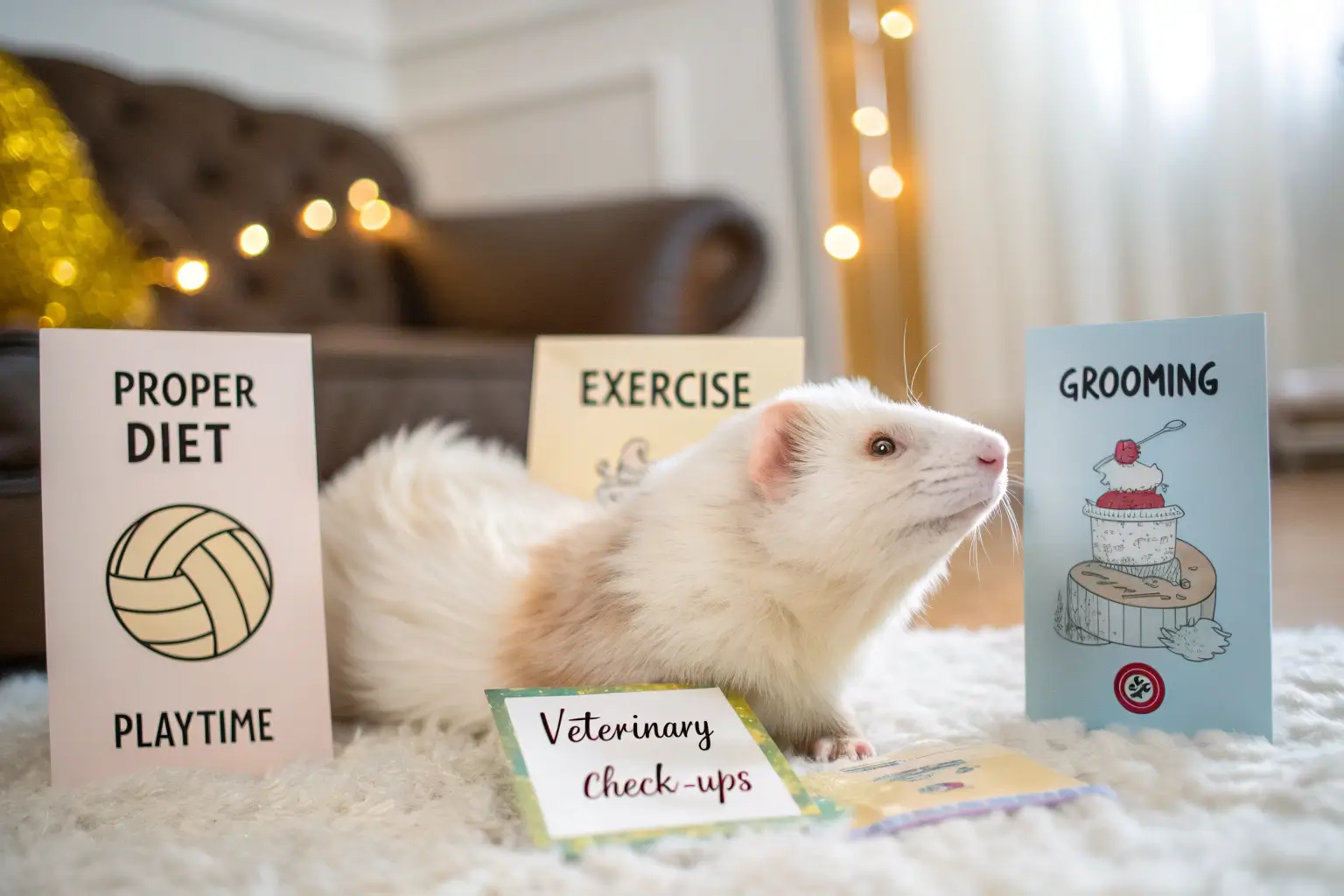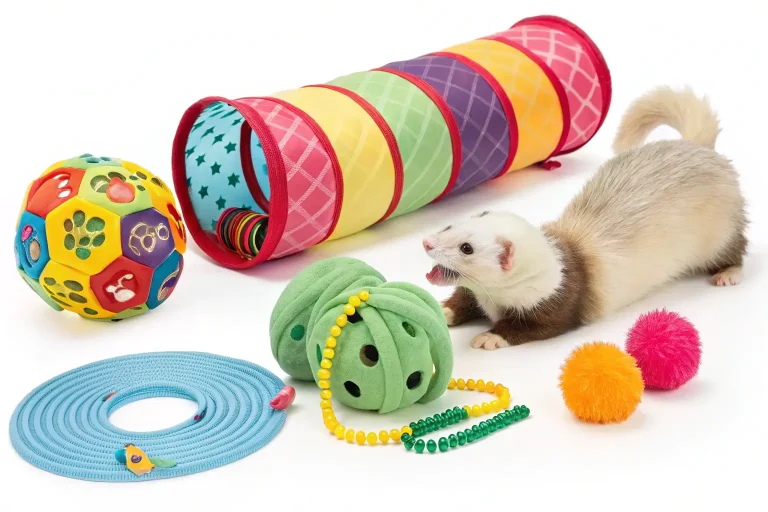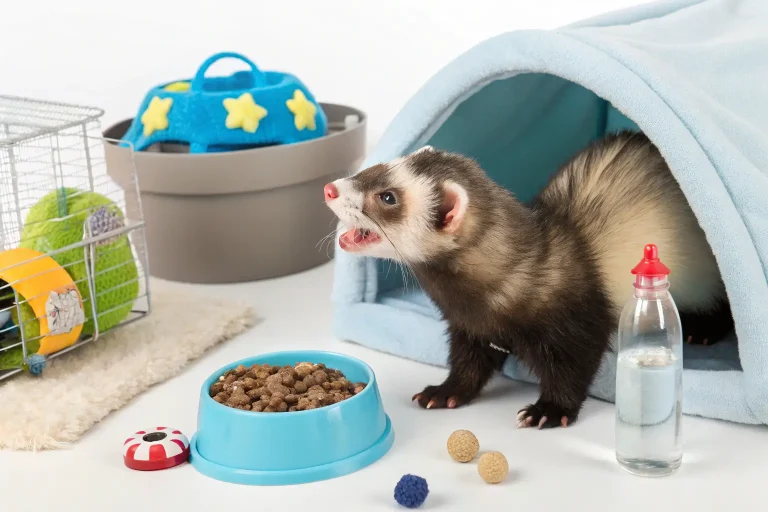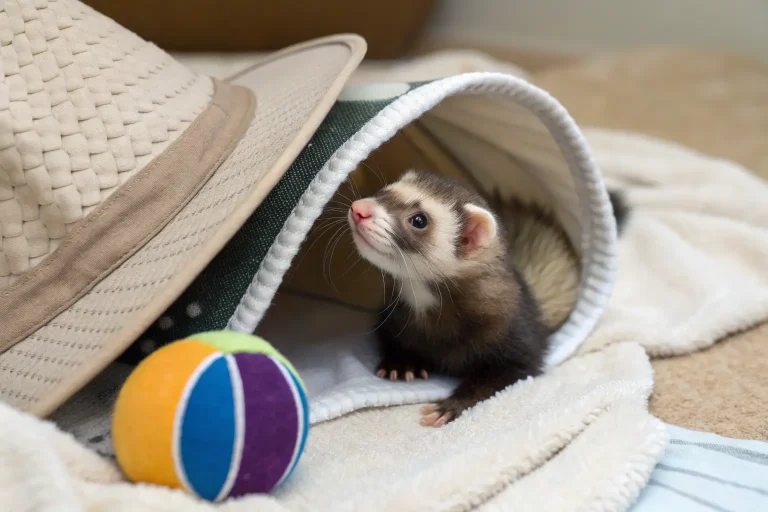5 Essential Angora Ferret Care Tips for a Happy Fluffy Friend
Are you enchanted by those impossibly fluffy, cloud-like creatures known as angora ferrets? These special long-haired beauties require specific care to keep their luxurious coats healthy and their playful spirits thriving. Whether you’re a new angora ferret parent or looking to improve your care routine, understanding the unique needs of these extraordinarily fuzzy companions is essential. This comprehensive guide unveils the five most crucial care tips to ensure your angora ferret lives its best, fluffiest life.
Introduction
Angora ferrets, with their stunning long silky coats and charming personalities, have captured the hearts of exotic pet enthusiasts worldwide. These special ferrets aren’t actually a separate species but rather ferrets with a genetic mutation that results in their gloriously long fur. Proper care for an angora ferret requires specific knowledge beyond standard ferret care, particularly when it comes to coat maintenance and health considerations.
The importance of learning proper angora ferret care cannot be overstated. Their distinctive coats make them susceptible to unique challenges that ordinary ferrets don’t face. Without proper attention, these magnificent creatures can experience discomfort, health issues, and a diminished quality of life.
Did you know that despite their delicate appearance, angora ferrets descend from working animals? Their ancestors were bred for hunting, displaying the same tenacious spirit that hides beneath all that fluff. This combination of beauty and vigor makes angora ferrets particularly special companions.
Species Overview
Scientific Name: Mustela putorius furo (with the angora trait)
Physical Characteristics: The angora ferret is distinguished primarily by its extraordinarily long, silky fur. This luxurious coat can grow up to 2-4 inches in length, creating that signature fluffy appearance. They typically weigh between 1-4 pounds, with males (hobs) being larger than females (jills). While they come in various color patterns including albino, sable, panda, and cinnamon, all angora ferrets share the same distinctive long-haired trait.
Genetic Background: The angora trait in ferrets is believed to be the result of a recessive gene mutation. Unlike regular ferrets that have a double coat consisting of guard hairs and undercoat, angora ferrets have longer guard hairs that continue to grow, much like human hair. This genetic distinction is what creates their unique appearance and necessitates specialized care.
Habitat and Distribution
Natural Habitat: Wild ferrets (European polecats) from which domestic ferrets descend are native to woodland edges, farmlands, and grasslands. However, angora ferrets are exclusively domestic animals, developed through selective breeding, and don’t exist in the wild.
Geographic Range: As purely domestic animals, angora ferrets can be found wherever they’re kept as pets. They’ve gained popularity in North America, Europe, and Australia, though they remain relatively rare compared to standard ferrets.
Adaptations: Angora ferrets retain many of the physical adaptations of their short-haired counterparts, including a flexible spine for navigating burrows, sharp teeth, and claws for hunting. However, their long coat would be impractical in the wild—it’s an adaptation specifically developed through human breeding programs for aesthetic purposes. In domestic settings, angora ferrets require climate control as their thick coats can make them susceptible to overheating.
Diet and Feeding Habits
What They Eat: As obligate carnivores, angora ferrets require a high-protein, high-fat diet with minimal carbohydrates. Quality commercial ferret food specifically formulated for their nutritional needs should form the basis of their diet. High-quality cat food with at least 36% protein and 20% fat can be an alternative when ferret-specific food isn’t available.
Nutritional Requirements: The angora ferret’s diet should consist of:
- High-quality animal protein (from meat, not plant sources)
- Animal-based fats
- Minimal carbohydrates (under 3% is ideal)
- Taurine and other essential amino acids
Feeding Schedule: Due to their high metabolism and short digestive tract, angora ferrets should have food available at all times. They typically eat 8-10 small meals throughout the day. Fresh, clean water should always be accessible, preferably through a bottle with a metal drinking tube to prevent their luxurious facial fur from getting wet and matted.
Treats: Occasional treats like small pieces of cooked meat, egg, or commercial ferret treats can be given sparingly. Avoid sugary treats, dairy products, and plant-based foods, as these can cause digestive issues and potentially impact coat health.
Behavior and Social Structure
Social Behavior: Angora ferrets, like all domestic ferrets, are highly social animals that thrive on interaction with both humans and other ferrets. They’re happiest when kept in pairs or groups called “businesses.” Their playful, curious nature makes them engaging pets, though their antics may occasionally be hidden beneath that magnificent fur!
Communication: These fluffy companions communicate through a range of vocalizations and body language. A happy angora ferret may perform the “weasel war dance”—a series of excited hops, spins, and bounces—though this might be less obvious than in short-haired ferrets due to all that fluff. They also communicate through soft clucking sounds when content, hissing when frightened, and barking when extremely excited or startled.
Sleep Patterns: Angora ferrets are crepuscular, meaning they’re most active at dawn and dusk. They sleep 14-18 hours daily, often in adorable, contorted positions. Many angora ferret owners note that their pets become particularly playful during the evening hours when human family members are home to interact with them.
Mating and Reproduction: Breeding angora ferrets requires specialized knowledge and should generally be left to experienced breeders. Females come into heat seasonally unless spayed, and when in heat can develop life-threatening aplastic anemia if not bred. For pet angora ferrets, spaying and neutering are recommended to prevent health issues and reduce musky odor.
5 Essential Angora Ferret Care Tips
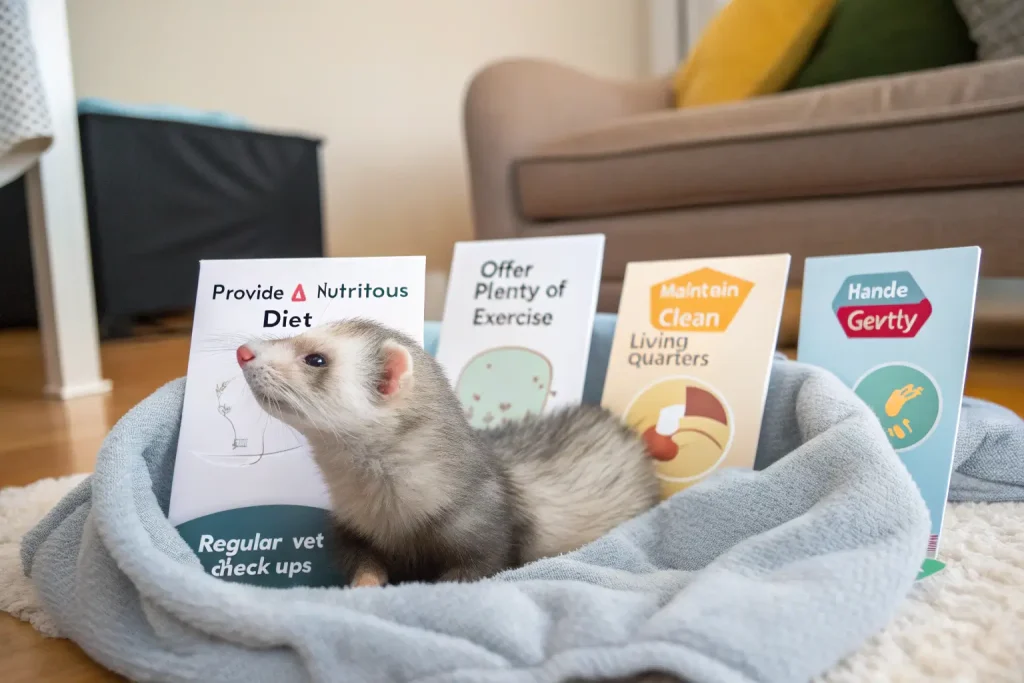
1. Master Proper Grooming Techniques
The hallmark luxurious coat of an angora ferret requires consistent maintenance to prevent matting and associated health problems. Unlike standard ferrets, angora ferrets can’t adequately groom themselves due to their excessive fur length.
Brushing Routine: Establish a daily brushing routine using a soft slicker brush and a fine-toothed comb specifically designed for long-haired pets. Start with the slicker brush to remove loose fur and minor tangles, then follow with the fine-toothed comb to catch any remaining knots.
Bathing Guidelines: Bathe your angora ferret no more than once monthly using a gentle, ferret-specific shampoo. Excessive bathing strips natural oils from their skin and coat, potentially causing dryness and irritation. After bathing, thoroughly dry your ferret with a soft towel followed by a low-heat blow dryer kept at a safe distance to prevent overheating.
Handling Matting: Address mats immediately as they can pull on skin, causing pain and potential skin infections. For minor mats, use your fingers to gently separate the tangled fur. For severe matting, consult a veterinarian experienced with angora ferrets—they may recommend careful trimming.
Seasonal Considerations: Angora ferrets experience more significant seasonal shedding than standard ferrets. During these periods, increase brushing frequency to twice daily to manage excessive fur loss and prevent ingestion of loose hair, which can cause digestive blockages.
2. Implement Specialized Nutrition for Coat Health
An angora ferret’s magnificent coat requires nutritional support from the inside out. Their diet directly impacts coat quality, shine, and shedding patterns.
Essential Fatty Acids: Supplement your angora ferret’s diet with omega-3 and omega-6 fatty acids to promote coat health. A quarter teaspoon of salmon oil or ferret-specific oil supplements a few times weekly can make a remarkable difference in coat luster and texture.
Protein Quality: Ensure your ferret’s diet contains high-quality animal proteins. Look for foods listing meat, poultry, or fish as the first several ingredients. Protein deficiency quickly manifests as dull, brittle fur in angora ferrets.
Hydration Strategy: Monitor water intake closely, as proper hydration is crucial for skin and coat health. Some angora ferrets drink less than they should because their facial fur gets wet at the water bottle. Consider water fountains or shallow dishes that minimize facial wetting.
Specialized Supplements: Talk to your exotic pet veterinarian about biotin supplements, which can strengthen fur and reduce excessive shedding. These may be particularly beneficial during seasonal coat changes or if your angora ferret shows signs of fur breakage.
3. Create an Angora-Friendly Environment
The unique physical characteristics of angora ferrets necessitate specific environmental considerations to ensure their safety and comfort.
Temperature Control: Angora ferrets are more susceptible to overheating than standard ferrets due to their insulating coats. Maintain environmental temperatures between 60-75°F (15-24°C). Install a thermometer in their main living area and provide cooling options during warmer months, such as ceramic tiles or specialized cooling mats.
Cage Design: Choose a cage with solid floors rather than wire bottoms, which can catch long fur and cause injury. Ensure all cage openings are properly sized—angora ferrets can sometimes squeeze through spaces that would trap standard ferrets due to their slippery, compressible coats.
Bedding Selection: Provide smooth bedding materials like fleece or ferret-specific sleep sacks that won’t tangle in long fur. Avoid fibrous materials like loose cotton or string bedding that can become entangled in their coat or be accidentally ingested.
Play Area Safety: Ferret-proof play areas with special attention to spots where long fur might get caught. Secure or remove small gaps in furniture, eliminate access to sticky substances like tape or glue, and regularly inspect toys for parts that could entangle fur.
4. Establish Preventative Health Protocols
Angora ferrets require vigilant health monitoring due to their coat’s ability to hide early signs of medical issues.
Regular Body Checks: Institute weekly “fur-parting” sessions to examine the skin beneath that magnificent coat. Look for redness, irritation, parasites, or unusual growths that might otherwise go unnoticed until seriously advanced.
Weight Monitoring: An angora ferret’s fluffy appearance can mask unhealthy weight loss or gain. Weigh your pet weekly using a small digital scale and maintain a weight journal to track subtle changes that might indicate health problems.
Veterinary Specialist: Establish a relationship with a veterinarian experienced specifically with angora ferrets. Schedule bi-annual check-ups rather than the annual visits sufficient for standard ferrets, as their unique characteristics require more frequent professional assessment.
Vaccination Schedule: Maintain a rigorous vaccination schedule including canine distemper and rabies. Some angora ferrets may have more sensitive reactions to vaccines, so discuss a potentially modified schedule with your exotic pet veterinarian.
Parasite Prevention: Implement a year-round parasite prevention program. External parasites can be particularly problematic for angora ferrets, as fleas and mites can hide deep within their luxurious coats, causing significant damage before detection.
5. Balance Exercise With Coat Protection
Angora ferrets need the same vigorous exercise as standard ferrets while protecting their special coats from damage during play.
Supervised Play Sessions: Schedule 3-4 daily play sessions of 20-30 minutes each outside their cage. Supervise these sessions to quickly address any fur entanglements in toys or furniture.
Appropriate Toy Selection: Choose smooth, solid toys without small parts, fabric fringes, or rubber components that could be chewed off and swallowed. Tunnels with smooth interiors, solid plastic balls, and specially designed ferret puzzles are excellent options.
Grooming After Play: Implement brief grooming sessions after vigorous play to remove any debris or tangles acquired during activity. This preventative approach stops minor tangles from developing into serious mats.
Exercise Timing: Schedule more intensive play during cooler parts of the day to prevent overheating. Watch for signs of excessive warmth including heavy panting, lethargy, or seeking out cool surfaces, which indicate your angora ferret needs a break and cooling down.
Swimming Considerations: While many standard ferrets enjoy water play, be cautious with angora ferrets. Their heavy coats become extremely weighty when wet and dry slowly, potentially causing chilling. If your angora ferret shows interest in water, allow only shallow exploration followed by thorough drying.
Conservation Status
Angora ferrets, as a domestic variety, don’t have a conservation designation. However, their wild ancestors, the European polecat (Mustela putorius), are listed as Least Concern on the IUCN Red List, though they face threats from habitat loss and fragmentation in parts of their range.
Domestic ferrets, including angora varieties, have been selectively bred for over 2,500 years and are entirely dependent on human care. Their future as a distinct variety relies on responsible breeding practices and proper education about their specialized needs.
Interesting Facts
- The angora trait in ferrets is believed to have first appeared as a natural mutation in the late 20th century and was subsequently developed through selective breeding.
- Despite their delicate appearance, angora ferrets retain the playful, mischievous personality of standard ferrets.
- Their luxurious coat continues growing throughout their lives, unlike standard ferrets whose fur length remains relatively constant.
- The term “angora” is borrowed from angora rabbits and goats, which similarly have long, silky fur.
- Angora ferrets can sometimes appear nearly twice their actual size due to their fluffy coats, earning them the nickname “furry potatoes” among enthusiasts.
- Their fur is so dense that an angora ferret can feel significantly heavier than a standard ferret of the same weight when picked up.
Role in the Ecosystem
As purely domestic animals, angora ferrets don’t play a role in natural ecosystems. However, they fulfill important roles in human households:
Companionship: These affectionate, intelligent animals form strong bonds with their human caretakers, providing emotional support and entertainment.
Educational Value: Caring for these specialized animals teaches responsibility, biology, genetics, and animal husbandry principles.
Community Building: Angora ferret enthusiasts often form tight-knit communities that share information and support, connecting people across geographical and cultural boundaries through their shared interest.
Conclusion
Caring for an angora ferret offers unique rewards and challenges that differ significantly from standard ferret care. Their extraordinary coats require consistent maintenance, their health needs vigilant monitoring, and their environments thoughtful preparation. By implementing these five essential care tips—mastering grooming techniques, providing specialized nutrition, creating an angora-friendly environment, establishing preventative health protocols, and balancing exercise with coat protection—you’re setting the foundation for a thriving relationship with your fluffy companion.
The extra effort required to maintain an angora ferret’s magnificent appearance pays dividends in the form of a striking, healthy pet whose unique beauty turns heads and captures hearts. With proper care, your angora ferret can live a full, active life of 6-10 years, bringing joy and fluffy antics to your home for many years to come.
If you’re considering adding an angora ferret to your family, connect with reputable breeders, rescue organizations specializing in ferrets, and online communities dedicated to these special animals. The knowledge, support, and advice from experienced angora ferret enthusiasts can be invaluable in your journey with these extraordinary pets.
Frequently Asked Questions
How often should I bathe my angora ferret?
Bathe your angora ferret no more than once monthly to avoid stripping essential oils from their skin and coat. Spot cleaning with a damp cloth can address minor soiling between baths. Always use ferret-specific shampoo and ensure thorough drying afterward.
Are angora ferrets more expensive to maintain than standard ferrets?
Yes, angora ferrets typically require additional expenses including specialized grooming tools, more frequent veterinary care, climate control considerations, and potentially special dietary supplements for coat health. Budget for approximately 25-30% higher annual costs compared to standard ferrets.
Can angora ferrets live with standard ferrets?
Absolutely! Angora and standard ferrets can be wonderful companions for each other. Their behavioral needs and social structures are identical, though you’ll need to monitor the angora’s coat for any damage during rough play sessions.
Do angora ferrets smell more than standard ferrets?
When properly cared for, angora ferrets don’t necessarily smell stronger than standard ferrets. However, their abundant fur can trap odors if not regularly groomed. Proper diet, regular grooming, and appropriate cage cleaning routines will minimize any musky scent.
How can I tell if my angora ferret is overheating?
Watch for signs including heavy panting, excessive lethargy, sprawling on cool surfaces, reduced activity, and seeking out shadowed areas. Their thick coats make them particularly susceptible to heat stress, so be vigilant about monitoring for these warning signs, especially during warmer months.

